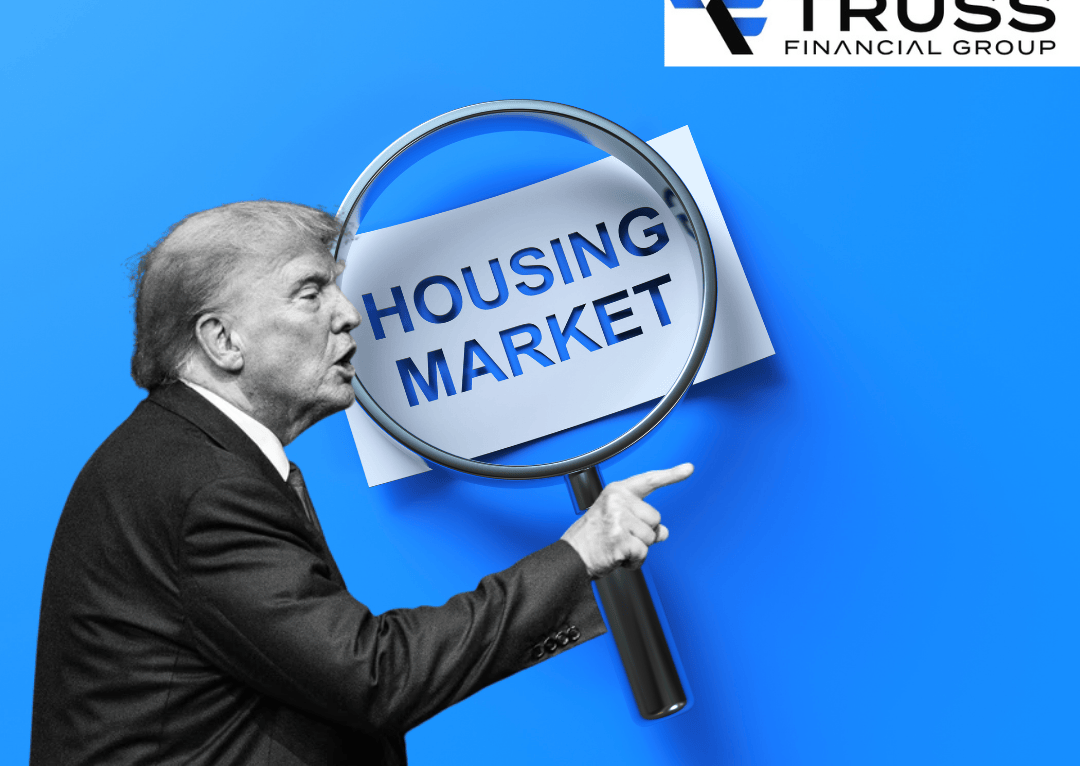12 min read

-
Tariffs: A 25% duty on Canadian lumber and proposed 20–60% tariffs on materials from China and Mexico add up to $10,000 per new home.
-
Labor shortages: Immigration restrictions have cut the construction workforce by roughly 30%, slowing projects and raising prices.
-
High mortgage rates: 30-year loans remain around 6.75–7.1%, keeping buyers sidelined.
Trump’s second term is reshaping the U.S housing market in ways that are too fast to even wrap our heads around. With new, aggressive tariffs, threats of mass deportation, and sweeping deregulation, the current administration’s economic outlook is anything but subtle.
As a buyer locked out by unfathomable mortgage rates or a builder left speechless looking at the rise in material costs, what you need is a cold, hard analysis of the real estate industry in 2025 and ahead.
Yes, home prices are at an all-time high. Yes, interest rates remain elevated. And yes, affordability is out of reach for millions. But amidst the uncertainty, there’s an opportunity for those willing to look.
Here’s everything you need to cut through the noise and understand about the housing market under Trump.
Key Takeaways
-
Housing affordability is under pressure due to rising construction costs, high mortgage rates, and labor shortages.
-
Trump’s tariffs have raised the cost of new housing, with home builders passing those costs to buyers.
-
Despite promises of deregulation and opening federal land for development, the housing shortage persists.
-
Immigration reform and labor crackdowns are tightening the construction industry workforce.
-
Younger buyers are moving to lower-cost suburbs and demanding sustainable, flexible housing options.
-
Political shifts, including the Trump administration’s trade and economic policies, are injecting uncertainty into the mortgage industry and long-term housing supply planning.
Factors Affecting Housing Affordability
For millions of Americans, housing affordability remains one of the most pressing challenges as the dream of homeownership becomes a distant thought.
Rising Construction Costs Driven by Tariffs
The Trump administration’s new tariffs have escalated construction costs. Earlier this year, a 25 % tariff on Canadian softwood lumber was reinstated. While the aim was to promote domestic production, builders faced immediate price hikes. Roughly 30 % of the U.S.’s softwood lumber is imported from Canada, which is why there’s such a direct and outsized impact on homebuilding costs.
According to the National Association of Home Builders (NAHB), tariffs on lumber and other building materials are adding approximately $7,500 to $10,000 to the cost of building a single-family home.
But that’s not the only issue.
Proposed tariffs of up to 20 to 60 % on nails, drywall, appliances, and other building materials imported from China and Mexico are expected to further inflate prices.
The rising cost of labor because of labor shortages, especially due to the latest immigration policies, is bound to compound the existing problem.
High Mortgage Rates and Tight Credit
Mortgage rates aren’t too far behind either.
As of Q2 2025, 30-year fixed mortgage rates are averaging between 6.75 % to 7.10 %, depending on the loan type and borrower’s credit score. While these levels are below the peak we experienced in 2023, it’s still double what buyers were paying just 5 years ago!
As tariffs drive import costs to an all-time high, the Federal Reserve is pushed into maintaining higher interest rates, causing potential homebuyers to think twice before entering the market.
Lenders have also tightened credit requirements. Without government-backed programs and fever low-down-payment options available, several buyers are priced out. Qualifying for a loan large enough to afford a home seems completely out of the question.
Limited Supply of Affordable Housing
According to the Urban Institute, the U.S. is currently facing a 3.8 million-unit housing shortage. Although Trump proposed opening up federal land for development, several have argued against it, claiming that these parcels are located far from job centers and lack basic infrastructure.
There have been quite some efforts put into easing local zoning laws and reducing federal red tape, in hopes of boosting housing starts. However, this will likely take years to materialize. In the meantime, builders continue to prioritize higher-margin developments over affordable housing.
Government Initiatives and Policy Gaps
Another major factor affecting housing affordability is the gaps in policies and government initiatives. Earlier this year, in February, the Trump administration announced a revamped Housing Affordability Tax Credit, which aimed to incentivize developers to build low-income units.
However, several critics, including the Mortgage Bankers Association, argue that the credits don’t go far enough and often even fail to address the deeper structural issue.
The proposed budget cuts to the Department of Housing and Urban Development and plans to consolidate housing programs under the Department of Government Efficiency have raised several concerns. A major one is the long-term funding for affordable housing options.
If these cuts are implemented, vulnerable populations, such as veterans, low-income families, and seniors, could potentially lose access to housing support services.
Economic Impacts on Housing
It’s important to understand that the U.S. housing market doesn’t operate in a vacuum. It’s affected by broader shifts in the economy.
Growth Vs. Instability
President Trump has emphasized economic growth through deregulation, tax cuts, and increased domestic manufacturing. However, the benefits for the housing industry remain uneven.
On one hand, we’re noticing a pent-up demand among first-time buyers who are waiting to re-enter the market. On the other hand, trade frictions and rising inflation have driven up borrowing costs and disrupted supply chains.
Key Drivers and Challenges
-
Mortgage and Interest Rates: As mentioned earlier, the Federal Reserve has kept interest rates high due to persistent inflation. Most of this is triggered by Trump’s tariffs on goods like softwood lumber and steel. Because of this, housing affordability has taken a hit.
-
Trade Policy Fallout: The new tariffs have hit the construction industry as well. Import taxes on building materials from Canada, Mexico, and China have also increased construction costs. This, in effect, has driven home prices up, further widening the housing affordability crisis.
-
Job Creation Through Homebuilding: Despite these headwinds, the housing sector remains a focal point for economic activity. It has increased jobs in architecture, logistics, and real estate.
The Broader Picture
Trump’s presidency is one of contradictions.
We’ve got strong job numbers but weak housing starts. Record high home valuations but flat wage growth. An aggressive tariffs policy but with highly unpredictable results.
This has led to:
- Higher mortgage rates, which discourage new borrowing
- Trade policy instability, which drives inflation in the construction sector
- Immigration reform, which reduces labor availability
For many, the current environment demands caution.
Buyers, especially those hunting for affordable homes, are increasingly worried about buying at the peak of a volatile cycle. Sellers, on the other hand, are seeing fewer offers as buyers retreat in the face of rising costs and economic uncertainty.
Demographic Changes and Housing
This year, we’ve seen a major demographic transformation take place on both sides of the equation. These shifts are shaping the types of homes being built, their buyers, and locations.
Population Trends Driving Market Shifts
While Baby Boomers are downsizing or moving into retirement communities, Millennials and Gen Z are just getting started.
However, that doesn’t mean housing affordability isn’t still a major barrier for this bunch.
- Millennials and Gen Z buyers are prioritizing affordable homes and spaces for remote work.
- Many are migrating from expensive coastal metros to suburban markets with lower housing costs.
- Home builders are adapting by focusing on single-family homes in suburban zones.
Immigration Reform and Labor Shortages
Trump’s immigration policies, which have proposed mass deportations and visa restrictions, have hit the construction industry severely.
- According to the National Association of Home Builders, 30 % of U.S. construction workers are foreigners.
- The recent immigration crackdowns have led to labor shortages, slower construction, and skyrocketing home prices.
Changing Consumer Preferences
If you take a look at homebuyers’ priorities, you’ll see they’ve shifted dramatically over the past 5 years. Ever since the pandemic, we’ve seen a higher demand for housing options that support a flexible and sustainable lifestyle.
- Remote work is here to stay, and it only makes sense for housing options to include office spaces and high-speed internet.
- Buyers are increasingly worried about environmental impact, which has pushed developers toward energy-efficient options.
- There's also growing interest in solar panels, smart HVAC, and app-integrated utility controls.
Urban Revitalization and Community Planning
Many cities are currently undergoing urban development and revitalization, which have helped create livable and sustainable communities. This includes investments in:
- Mixed-use developments that bring residential, commercial, and recreational spaces close by
- Affordable housing incentives in gentrifying neighborhoods to balance rising housing prices.
- Transit-oriented housing projects that reduce commuting costs and increase accessibility.
Federal, state, and local governments, along with federal agencies, are deploying zoning reforms and tax credits to encourage new investments in high-demand areas. These projects aim to address long-term home affordability while keeping displacement and overdevelopment in check.
Market Trends and Forecasting
Keeping up with the housing market in 2025 isn’t easy. So much is changing: prices, mortgage rates, and government policies, all at once. If you're planning to buy, sell, or invest in a home, understanding the latest trends can help you make smarter decisions and avoid costly mistakes.
What the Experts Are Saying
Industry groups like the National Association of Home Builders, Freddie Mac, and Fannie Mae expect home prices to go up steadily this year, around 3% to 5%. This is mostly because there aren’t enough homes available, and more people still want to buy.
- Experts estimate we’re still short by about 4 to 5 million homes nationwide.
- While builders are trying to catch up, they’re facing big challenges like rising construction costs, material shortages, and Trump’s tariffs on items like softwood lumber.
- At the same time, mortgage rates have gone up, making it harder for buyers to afford monthly payments.
Technology Is Changing How We Buy Homes
One of the biggest shifts in recent years is how much technology is now involved in buying and selling homes. Whether you're checking listings online, getting pre-approved for a mortgage, or doing virtual tours, everything is faster and more digital.
- Many lenders now use apps and online tools to speed up the mortgage process.
- Homebuyers are using price comparison tools and real-time calculators to understand how much they can afford.
- First-time buyers especially appreciate this tech because it makes a complicated process feel more manageable.
How Politics Are Shaping the Market?
- Tariffs have made building materials more expensive.
- Tighter immigration rules are reducing the labor available for new home construction, which can cause delays and raise prices even more.
- Economic decisions from the White House and federal agencies are making the market less predictable.
Where Are Prices Going?
- Fast-growing cities like Tampa, Raleigh, and Austin are still hot markets with strong demand.
- Expensive metros like San Francisco or New York are seeing people move out in search of affordable homes and lower housing costs.
FAQs
Will The Housing Market Crash In 2025
We’re not expecting a full-blown crash. Prices might cool down in some overheated housing markets; however, a limited housing supply and strong demand are bound to keep a full-blown collapse off the table.
When Will The Housing Market Crash Again?
While it’s hard to predict, most economists don’t expect another major crash soon. As long as lending stays tight and supply remains low, any downturn should be gradual.
Will The Election Change The Housing Market?
Yes, housing is always affected by political changes. President Trump’s return has already impacted the housing sector profoundly.
Will Trump Make Housing More Affordable?
Honestly, only time can tell. Opening federal land and cutting red tape will likely boost supply, but tariffs and labor shortages are only driving construction costs higher.
What Is Trump’s Housing Plan, And Property Values?
The plan includes deregulation, immigration reform, and the use of federal land.
Conclusion
Trump’s policies have transformed the U.S. housing market profoundly. Amidst tariffs, mass deportation, and a firm push towards deregulation, it’s important to adapt quickly to stay ahead. Truss Financial Group guides you through these complexities.
We can help you find tailored solutions for your homeowning goals. The uncertainty is inevitable, but you don’t have to face it alone. Contact us today to turn today’s market shifts into tomorrow’s opportunities.
Table of Content

Take your pick of loans
Experience a clear, stress-free loan process with personalized service and expert guidance.
Get a quote


.png?width=352&name=White%20Gray%20Monochrome%20Business%20Company%20Blog%20Banner%20(14).png)